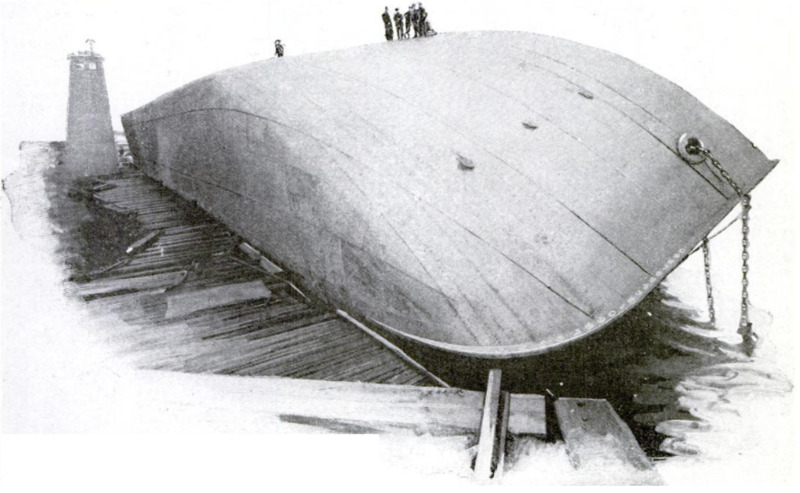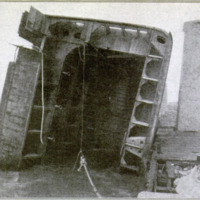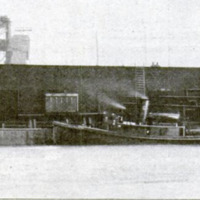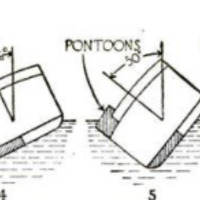-
Titolo
-
How the Americans managed to get a lake vessel, which was too large to navigate North America canals and rivers, to the Atlantic Ocean
-
Article Title and/or Image Caption
-
Title: The Story of a Big Ship and a Little Lock
-
Subtitle: Getting a fifty-foot boat through a forty-four-foot canal
-
extracted text
-
ONE hundred and ninety lake ves-
sels were taken over by the
United States Shipping Board
when America entered the war. Forty-
eight of these were brought out to the
Atlantic seaboard by way of the Wel-
land Canal around Niagara Falls and
down the St. Lawrence river before the
closing in of the ice in the winter of
1917, and thirty-five more subsequent
to the opening of navigation in the
spring of 1918.
Many of these vessels were longer
than the locks in the canal. It was
not a difficult task to cut these in
half, bulkhead the open ends, and take
them through in two parts. But the
Charles E. Van Hise (460 feet long,
50 feet beam, and 43 feet 8 inches from
keel to gunwale) presented a more
difficult problem. She was not only
t00 long, but also too wide. Her beam
of fifty feet was six feet more than the
width of the locks.
We Need the Ships
Ships are needed mow almost as
badly as they were when the submarine
peril was at its height. Hence the prob-
lem of getting the Van Hise through
was put squarely before the engineers
of the Shipping Board for solution.
They accomplished their task with
the cutting of the ship in but one place.
This was amidships, just as in the boats
that had a beam less than the width of
the locks. But with that operation
the similarity ended. The narrower
boats were taken through the locks on
an even keel, but the Van Hise had
to be tipped over on her side and
floated on her beam ends, with her
deck vertical to the water.
No other ship approaching the Van
Hise in size had ever to be manipulated
in a like manner. The engineers had
no precedent to follow.
Bow and Stern Separated
The bow was cut in two, turned on
its side, and passed through one lock
of the canal on December 5 last. The
stern section, containing the engines
and boilers, was handled separately.
Alter proving that the daring plan of
handling the Van Hise was successful,
the engineers decided that the season
was too far advanced to make it safe
to send the ship on her strange voyage.
She is wintering in Lake Erie and
will make the trip through the canal in
the spring.
The first step in the work on the
bow section was to bulkhead the cut
end, and then to make the deck water-
tight by sealing all the hatches and
covering all the portholes and other
openings above the waterline on the
side of the ship that would be under
the water when the vessel was turned
on her side.
Over on Her Side
The next step was to mount six
adjacent wood and steel pontoons
about nine and one half feet long and
between five and six feet deep, on
the upper deck of the boat between
the forecastle and the rise of the
bridge-deck amidships. These pon-
toons were mounted entirely on the
deck and extended clear to the side
of the hull, which would be under
water when the vessel was turned
over. |
The boat was now ready for the,
turning operation. Gradually the
pontoons and other tanks inside of the
vessel were filled with water, so that
she became unbalanced and turned
over on her side without any ill effects,
much as you turn over in the water
while swimming.
The inner bottom on the side toward
the turn was first filled with 172 tons
of water. This tilted her slightly.
Then 130 tons of additional water!
ballast was added in the side tanks,
and finally 466 tons more was pumped.
into the pontoons, thus tipping the’
boat until she lay over on her side.
Tn addition to this total of 768 tons,
of water, 135 tons of equipment was|
used as ballast. Since the pontoons
weighed 105 tons, the grand total of
1,008 tons was required to turn the
forward section, weighing 1,700 tons.’
The water and other ballast made
the boat float with a draft of four-
teen feet.
The turning operation was done, not’
in the locks, but in Lake Erie near;
Buffalo. The bow section was first;
towed upright to a suitable place.
Then the pumps were started, steam
being furnished by accompanying tugs,
and after five hours the tanks and
pontoons were filled, whereupon the
section rolled over perfectly on its side.
It was then towed back to Buffalo, |
where leaks and other minor repairs
were made. This done, it was towed |
to Port Colborne, the entrance to the
canal. In the spring it will go on
through the locks. |
Gelling the Stern Through
The stern section will be floated
through in a similar manner. It was
first planned that the two sections
should be righted before being joined
together again. But now the en- |
gineers, F. A. Eustis, H. N. Herriman, |
and. W. F. Powers, hope to. join the
two halves as they lie floating on their
sides, and without putting them into |
dry-dock.
First of all, they will calk and paint
that portion of the vessel that is out of
water; then they will roll her over, |
remove the pontoons, shift the ballast,
and complete the other side in the
same manner. |
-
Autore secondario
-
Joseph Brinker (Article writer)
-
Lingua
-
eng
-
Data di rilascio
-
1919-03
-
pagine
-
54-55
-
Diritti
-
Public domain (Google digitized)
-
Archived by
-
Davide Donà
-
Marco Bortolami (editor)









